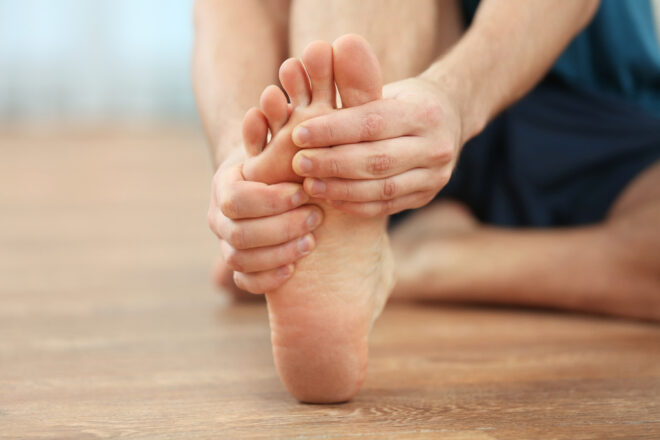Have you lately felt top of foot pain running? Many runners experience this type of pain at some point.
Often, it’s not serious, but it’s important to understand what may cause it. Treating it early is crucial to ensuring it won’t get worse.
Read on to learn more about the causes and treatments of pain on the top of your foot as you’re running.
In This Article:
What Causes Pain on Top of the Foot for Runners?
Pain in the foot can have multiple causes. It can be runner’s feet or another running injury brought on by strain or overuse. Here are the most common causes.
Extensor tendonitis
The extensor tendons flex up the foot and toes. They connect the muscles at the front of your legs to the toe bones. Similar tendons perform the same function in the hand. This is why some athletes also experience extensor tendonitis in the hand.
Symptoms
Extensor tendonitis causes pain in the front of your foot, often between the ball of your foot and the ankle. Other symptoms of extensor tendonitis include swelling and tightness in your calf muscles. Bruising on top of the foot is another common symptom.
Causes
Pain occurs when the extensor tendons, such as the extensor digitorum, become inflamed. Tendonitis on top of the foot often kicks in after you overtrain, especially on uneven surfaces. Running uphill or downhill places more stress on your feet. It can make extensor digitorum longus pain worse.
Other causes of extensor tendonitis include wearing tight running shoes or lacing up too tightly.
What to do
Rest is key – stop running while you’re in pain. You can then treat extensor tendonitis foot pain with the rest-ice-compress treatment approach. Tendonitis foot treatment is similar to that for other conditions causing similar pain. We’ll cover extensor tendonitis treatment in more depth later in this post.
Stress fractures
Repeated strain on your feet can cause stress fractures. Stress fractures can affect the metatarsal bones at the top of the feet. It can cause pain and potential complications if left untreated.
Symptoms
In addition to pain on top of the foot after running, stress fractures of the foot bones can cause other types of pain. When the fractures affect other bones, you may also experience pain on the outside OR the inside of your foot. Bruising is another common symptom.
Causes
Tiny fractures in your foot bones may appear because of overtraining or putting repeated strain on your feet. Having a high body mass index and undertrained leg muscles can increase the risk for stress fractures. This occurs because your foot bones will have more weight to bear. When it’s the result of a stress fracture, top of foot pain involves the metatarsal bones at the top of the feet.
What to do
Stop running, avoid putting more stress on the foot, and talk to your doctor. It’s important to address a stress fracture early. Else it may develop into a more serious fracture.
Arthritis
Arthritis is one of the rarer causes of top of foot pain after running. But since it can occur at any age, it’s important to rule it out.
Symptoms
Midfoot arthritis symptoms tend to develop over time and don’t go away on their own. Walking or running makes the pain worse. You may notice swelling, tenderness, and stiffness. A bony growth on top of your foot may also be a sign of the condition.
Causes
Arthritis in the foot can occur after a fracture or dislocation. It’s known as post-traumatic arthritis. More rarely, it can be osteoarthritis or rheumatoid arthritis affecting other bones in your body. Causes can include genetics, infections, and metabolism and immune system dysfunctions.
What to do
After resting and treating the symptoms of the pain, it’s important to see your doctor. They will suggest further tests to discover whether arthritis is to blame and recommend a treatment.
Bone spurs
Bone spurs are painful growths that may occur in the foot. They commonly occur along joints. Depending on their location, they may cause pain at the top of your foot.
Symptoms
A painful bump on top of the foot may go with the pain. You may also experience stiffness when trying to move your foot. If the bone spur presses on a nearby tendon, the latter may become inflamed, causing tendinitis.
Causes
Bone spurs in the foot can occur because of repeated stress on the bones of the foot. Wearing tight running shoes and being overweight can increase the risk. Other risk factors are osteoarthritis or having tight ligaments.
What to do
Wearing more comfortable running shoes and losing weight helps manage bone spurs. To deal with the pain, apply the same treatment plan as for other injuries causing the top of the foot pain.
Treating the top of the foot pain
If you’re asking yourself, “Should I keep running when the top of my foot hurts?” the answer is no. The same is true whether you get heel or arch pain running.
Rest
Relieving stress from your foot promotes healing. As soon as you experience top of foot pain after running, stop running. Try not to put any extra strain on your foot. Avoid long walks and other activities.
When seated, keep your foot in a comfortable position. You can elevate your foot using a footstool or pillow. Without rest, the pain may become more severe. What’s more, the injury may worsen. For example, a stress fracture may become a full-on fracture.
But what if rest means interrupting your preparation for a race you’ve been looking forward to? Rest is crucial to give your bones and tissue the time to recover. Training with top of foot pain could end up sidelining you for months.
Ice
Applying an ice pack to the painful area will reduce the swelling and numb the pain. Use an ice pack covered in a light towel to avoid direct contact with your skin. If you don’t have an ice pack, use a bag of frozen vegetables or anything similar.
Ice the painful area every 4–6 hours or more often for 48 hours. Apply the ice for up to 20 minutes at a time.
Compression
As part of your treatment, you can also start using an extensor tendonitis foot brace. Wrapping your foot for extensor tendonitis may also help better manage pain and prevent the worsening of the injury.
A foot brace or similar support can also limit joint movement and help your foot heal faster.
New shoes
Upgrading your running shoes may also be a good idea. Say no to running shoes that are too tight or that don’t provide enough support for your feet. When shopping for new running shoes, consider your pronation type. If you have recurrent foot pain, also consider orthotic inserts.
A foot cast or walking boot
By reducing movement in your foot, a foot cast or walking boot could speed up healing. It may enable you to walk without further pain. You could also wear it at night to reduce the risk of making the injury worse during sleep. A cast or walking boot may be necessary for more serious injuries.
NSAIDs
Are the pain and swelling bad? Non-steroidal anti-inflammatory drugs (NSAIDs) like aspirin can provide quick relief from pain. They can be effective if you have an inflamed tendon or another type of foot inflammation. You can get NSAIDs over the counter.
Preventing the Top of Foot Pain Running
Top of foot pain during and after running can often be prevented. Here are some of the things you can do.
- Add to your workout exercises that strengthen your leg muscles. Stronger leg muscles can help the feet better bear weight when running. Many new runners have underdeveloped leg muscles.
- Eat a healthy diet for runners that contains vitamin D and calcium. These essential nutrients strengthen your bones. Also, consider taking supplements.
- Don’t overtrain or run hard for too long. Increase your mileage gradually, ideally following a running plan adapted to your fitness level.
- Always begin your runs with a warm-up and stretching.
- Stretch your feet and your legs before and after runs.
- Wear comfortable running shoes adapted to your pronation type. Avoid tight shoes. Consider adding arch-support inserts to them.
- Don’t lace your running shoes too tightly.
When to See Your Doctor
Top of the foot pain after running will often go away with rest and the treatments we shared with you. But if the pain is recurring or intense, it’s good to check with your doctor.
In rare cases, this type of foot pain may indicate a more serious condition like a stress fracture or arthritis. Seeing a doctor will enable you to receive the right treatment to manage the condition and keep on running with it.
Takeaway
Here’s a summary of the main points we’ve been discussing:
- Overtraining or repeated stress on your foot can cause foot inflammation.
- Top of foot pain after running can be the result of tendon inflammation, stress fracture, bone spurs, or arthritis.
- Other symptoms can include swelling, a painful bump, or bruising.
- Wearing tight running shoes or lacing them up too tightly can cause top of foot pain.
- Rest is crucial to make the pain go away. Icing and compression also help.
- Once extensor tendon inflammation subsides, you can run or walk with almost no pain.
- Talk to your doctor about intense or reoccurring pain to avoid long-term complications.
In the end, you can be a great runner without experiencing foot pain. Following a personalized running plan can make it easier to prevent overtraining and avoid injury. It will also help you build endurance and get faster.














